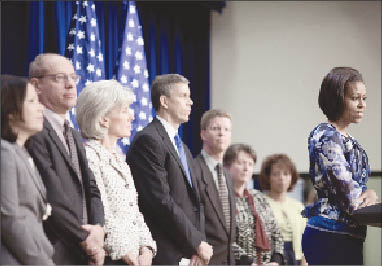 |
|
Let’s Move: First lady Michelle Obama unveils the findings of a childhood obesity report at the Eisenhower Executive Office Building in Washington. Photo: The White House |
Washington, D.C. – Lady Bird Johnson succeeded in beautifying America, but first lady Nancy Reagan’s appeals to “just say no” could not overcome the scourge of drug use among teens. What are the chances that first lady Michelle Obama can reduce childhood obesity in the United States?
That’s the goal Obama has carved out as her major project during her husband’s presidency, and she turned up that effort last month during several events at the White House and around the country, including the unveiling of a “roadmap” developed by a presidential task force.
The first lady is hopping on a bandwagon other groups have been driving for years, and more are joining. Her goal of reducing the rate of childhood obesity to 5 percent within a generation – by 2030 – faces obstacles as broad as the American agricultural distribution system and as deep as the current generation’s addiction to playing games by remote control. Childhood obesity now stands at about 20 percent. Being obese has traditionally been defined as being 20 percent above the ideal weight for a person’s height and age.
Obama’s approach is not limited to pushing more fruits and vegetables and schoolyard recesses. She and the task force target more root causes, such as making healthy foods as available in low-income neighborhoods as they are in wealthier areas and pushing exercise not only as a component of school recess, but also of after-school programs and everyday living.
Speaking at a news conference last month at which she unveiled the task force report, Obama said getting youth in shape does not necessarily require a new invention or discovery. “All we need is the motivation, the opportunity and the willpower to do what needs to be done,” she said.
The report names a few examples of programs that have been effective at getting youth to engage in physical exercise and lists a set of priorities on what needs to be done to combat the problem of childhood obesity in general, from expanding after-school programs to improving access to more healthy food.
During school visits and national addresses, Obama has showcased athletic activities to publicize her “Let’s Move” campaign.
What works?
Although a growing number of coalitions and task forces are embracing the problem, there are few, if any, evidence-based plans for reducing obesity on a large scale.
The Robert Wood Johnson Foundation, which launched its $500 million Childhood Obesity project three years ago to reverse the growing obesity problem by 2015, has not yet published detailed results of many specific local programs. It does report that Delaware, working with the foundation, has stopped the increase in childhood obesity through a statewide program emphasizing healthy living.
In addition, the foundation has spearheaded national action addressing calorie-laden foods that appeal to children, such as the removal of soft drinks from school buildings. As a result of its work with a national coalition, major food manufacturers last month announced a plan to remove 1.5 trillion calories from their products by 2015.
At least 15 state legislatures, the National League of Cities, the W.K. Kellogg Foundation, Kaiser Permanente and The California Wellness Foundation are among other groups that are addressing obesity.
According to the league’s report, Promoting Healthy Communities and Preventing Childhood Obesity: Trends in Recent Legislation, lawmakers are looking at land use to develop more “walkable” communities; connecting agriculture and education; and making better use of schools to teach nutrition and physical education.
There are studies that address fitness – considered the backbone of maintaining a healthy weight – and they show that being physically active improves academic performance.
“The higher a student’s fitness level, the higher their standardized test scores and school grades in both English and math,” according to the Student Fitness and Academic Performance Report for 2008-09, prepared by the Kaiser group for The California Endowment’s Healthy Eating, Active Communities initiative in Los Angeles.
Also coming from California recently is Changing Lives, Saving Lives – A Step-by-Step Guide to Developing Exemplary Practices, Healthy Eating, and Physical Activity and Food Security in Afterschool Programs, part of the California-based Center for Collaborative Solutions’ Healthy Behaviors Initiative.
That report describes programs, including those profiled here, that appear to have gotten youths to exercise or eat in ways that significantly improve their overall health.
Some of the techniques are simple, such as setting up obstacle courses with various stations where youths perform certain exercises so that, by the time their journey is complete, they will have had a full-body workout. Another uses a reality TV-inspired program with teams of children competing for the title of Top Chef, learning cooking skills and nutritional facts along the way.
Some offer traditional sports and recreation such as basketball, football, baseball, soccer and cheerleading. Other activities include skateboarding, capoiera (an Afro-Brazilian art form that incorporates martial arts, music and dance), track and field, yoga and fencing.
























